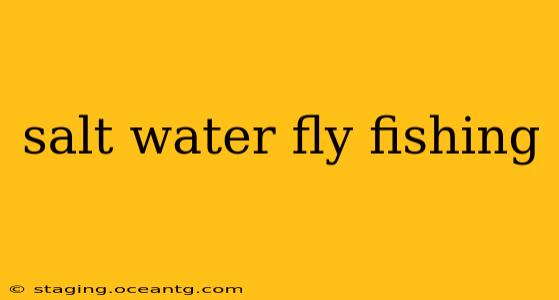Saltwater fly fishing offers an unparalleled thrill, pitting anglers against powerful, acrobatic fish in dynamic marine environments. From the bone-crushing runs of tarpon to the acrobatic leaps of bonefish, the challenges and rewards are unmatched. This guide delves into the intricacies of this exhilarating pursuit, catering to both newcomers and seasoned fly fishers looking to refine their saltwater techniques.
What Makes Saltwater Fly Fishing Different?
Saltwater fly fishing differs significantly from its freshwater counterpart. The sheer power of saltwater fish demands stronger equipment, specialized techniques, and a deeper understanding of marine ecosystems. The unpredictable nature of tides, currents, and weather adds another layer of complexity, requiring adaptability and experience. The fish themselves are often larger and more powerful, requiring more robust tackle and a different approach to fighting and landing them.
What Kind of Fish Can You Catch Saltwater Fly Fishing?
The diversity of saltwater fly fishing targets is astounding. Depending on location and season, you might encounter:
- Bonefish: Known for their lightning-fast runs and spooky nature, bonefish are a prized target for many saltwater fly fishers.
- Tarpon: These powerful giants provide an unforgettable fight, testing the angler's skill and equipment to the limit.
- Permit: Incredibly challenging to catch, permit are known for their discerning feeding habits and explosive bursts of energy.
- Redfish: These aggressive fish are often found in shallow, coastal waters and provide excellent sport.
- Snook: Another popular target, snook are known for their acrobatic jumps and powerful runs.
- Striped Bass (in certain saltwater areas): Found in coastal areas where freshwater rivers meet the sea, they provide a strong fight.
What Gear Do You Need for Saltwater Fly Fishing?
Choosing the right gear is crucial for success in saltwater fly fishing. This includes:
- Rod: A saltwater fly rod is typically stronger and more durable than a freshwater rod, capable of handling the powerful runs of saltwater fish. Lengths vary depending on the target species and fishing conditions.
- Reel: A large-arbor reel is essential for quickly retrieving line and managing the powerful runs of saltwater fish. It should be saltwater-resistant to withstand the corrosive effects of salt water.
- Line: Saltwater fly lines are usually heavier than freshwater lines, providing the necessary power to cast effectively into the wind and control larger fish. They often feature a durable coating to withstand abrasion.
- Leader: A strong leader is vital for connecting your fly to your line and withstanding the abrasiveness of saltwater. Fluorocarbon leaders are a popular choice due to their low visibility and strength.
- Flies: Saltwater flies are designed to mimic the natural food sources of saltwater fish. The type of fly used will vary depending on the target species and fishing conditions.
What are the Best Times and Places to Go Saltwater Fly Fishing?
The best time and place to go saltwater fly fishing depends largely on the target species. Researching the migration patterns and preferred habitats of your target fish is critical for success. Generally, warmer months offer better opportunities, but this varies significantly by location. Popular saltwater fly fishing destinations include the Bahamas, Florida Keys, Belize, and many other tropical and subtropical areas.
How Difficult is Saltwater Fly Fishing?
Saltwater fly fishing can be challenging, requiring patience, skill, and practice. The unpredictable nature of the saltwater environment, the power of the fish, and the specialized techniques involved all contribute to the difficulty. However, the rewards are well worth the effort.
What are Some Tips for Beginners in Saltwater Fly Fishing?
- Start with a guided trip: A professional guide can provide invaluable instruction and help you quickly learn the necessary techniques.
- Practice your casting: Accurate casting is essential for success in saltwater fly fishing.
- Learn to read the water: Understanding tides, currents, and other water conditions is crucial for locating fish.
- Use appropriate gear: Invest in quality saltwater fly fishing equipment that is appropriate for your target species.
- Be patient: Saltwater fly fishing often requires patience and persistence.
What is the best fly line for saltwater fly fishing?
The best fly line for saltwater fly fishing depends on factors like the target species, rod weight, and casting conditions. However, generally, weight-forward lines are preferred due to their ability to effectively load the rod and deliver flies accurately, particularly in windy conditions. Different tapers within weight-forward lines (e.g., short, intermediate, long) offer advantages based on specific casting needs. Consider the characteristics of your fishing location and the species you aim to target when selecting the most suitable line.
What are the Different Types of Saltwater Flies?
Saltwater flies boast remarkable diversity, mimicking crustaceans, baitfish, and other prey items. Popular types include:
- Crab patterns: Effective for attracting species that feed on crabs, such as redfish and bonefish.
- Shrimp patterns: Mimic various shrimp species, appealing to a wide range of fish.
- Baitfish patterns: Designed to imitate small fish, which are a common food source for larger predatory species like tarpon and snook.
- Clouser minnows: Versatile patterns that work well in various conditions.
This comprehensive guide provides a solid foundation for embarking on the thrilling adventure of saltwater fly fishing. Remember to prioritize safety, respect the environment, and practice responsible angling techniques. The rewards of this challenging and rewarding pursuit are immeasurable.
